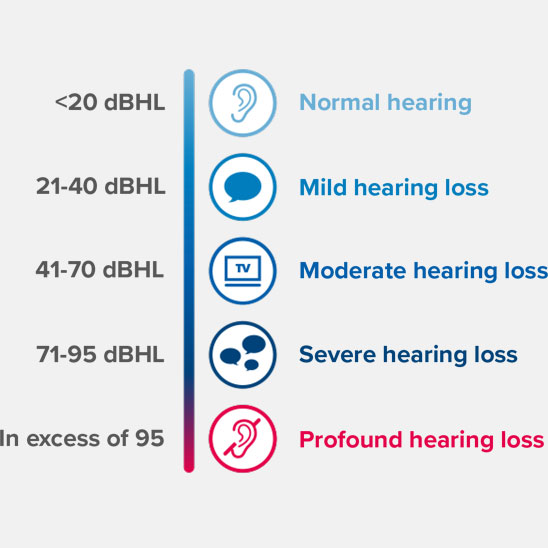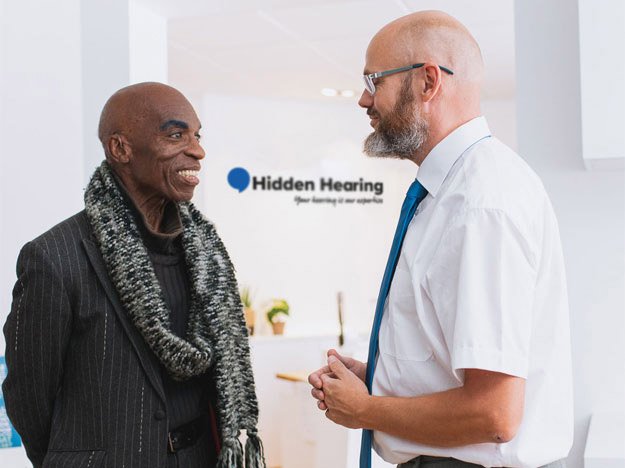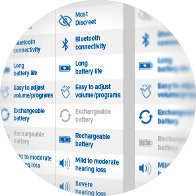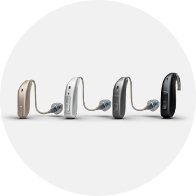
Your guide to selecting the best hearing aid for you
Choosing a hearing aid and having it fitted to suit your hearing needs can have a big impact on your quality of life. When choosing which hearing aid’s right for you, we recommend that you get advice from one of our professional hearing care experts.
Step 1. Compare available hearing aid styles
When it comes to hearing aids, knowing where to start can feel daunting. There are so many styles and features, it all seems a bit overwhelming.
To help get you started, we’ve put together the handy overview below.
It’ll help you understand the differences between each type of hearing aid. It shows what each kind of hearing aid looks like plus the features each type includes.
Once you’ve got to grips with this guide, you can move on to Step 2: what to consider when choosing hearing aids.
| Most discreet | ✔ | ✔ | ✗ | ✗ | ✔ | ✔ | ✗ | ✗ |
| Bluetooth connectivity | ✗ | ✗ | ✔ | ✔ | ✔ | ✔ | ✔ | ✔ |
| Long battery life | ✗ | ✗ | ✗ | ✔ | ✔ | ✔ | ✔ | ✔ |
| Easy to adjust volume and programs | ✗ | ✗ | ✗ | ✔ | ✔ | ✔ | ✔ | ✔ |
| Exchangeable battery | ✔ | ✔ | ✔ | ✔ | ✔ | ✗ | ✔ | ✔ |
| Rechargable battery | ✗ | ✗ | ✗ | ✗ | ✗ | ✔ | ✗ | ✗ |
| Mild to moderate hearing loss | ✔ | ✔ | ✔ | ✔ | ✔ | ✔ | ✔ | ✔ |
| Severe hearing loss | ✗ | ✗ | ✗ | ✔ | ✔ | ✔ | ✔ | ✔ |
| Profound hearing loss | ✗ | ✗ | ✗ | ✗ | ✗ | ✗ | ✔ | ✔ |
*the above hearing aids represent different types of Oticon models.

Book an appointment for your free hearing test
Try our new cutting-edge hearing aids with the latest technology.
Fill in your contact information, and we'll call you to set up an appointment in one of our clinics near you. It’s completely free and there's no obligation to buy anything.
Step 2. Six factors to consider when choosing a hearing aid
There are six main factors you’ll probably need to think about when choosing a hearing aid that’s going to be right for you.
- Your level of hearing loss
- Hearing aid technology
- Comfort
- Price and quality
- Style
- Lifestyle
Factor 1 – Your level of hearing loss
Your hearing loss severity will affect the types of hearing aids you can choose from.
That’s why it’s important to get your hearing tested and know your level of hearing loss, so you can understand which hearing aids will be best suited to you.
The 5 categories of hearing loss are:
- Normal hearing (≤25 dB)
- Mild hearing loss (26–40 dB): You may find quiet and soft conversations – or situations with only some background noise – more difficult to understand.
- Moderate hearing loss (41–60 dB): You need higher volume levels for radio and TV, and conversations accompanied by background noise become difficult to understand.
- Severe hearing loss (61–80 dB): You have difficulties with speech and group conversations in both quiet and noisy environments. Comprehension is impossible without amplification.
- Profound hearing loss (greater than ≥80 dB): It’s difficult or impossible for you to hear and understand amplified devices or speech in all environments.

Mild to moderate hearing loss:
You can choose any type of hearing aid (all the types represented in Step 1).
Severe hearing loss:
You can choose between selected types of hearing aids, such as “full-shell in-the-ear”, “miniRITE”, or “plus power behind-the-ear”.
Profound hearing loss:
The “plus power behind-the-ear” hearing aid will probably be the right solution for you. For very profound hearing loss, cochlear implants might be an option for those who are interested in a more permanent solution (as surgery is required.)¹
Conclusion
Do you know the level of your hearing loss?
To get an idea of your level of hearing loss, we suggest you book a free hearing test at your local hearing clinic. The consultation takes about an hour. After going through your results together, we’ll discuss your options so that we can tailor a solution specific to you.

Today’s advanced technology provides a more natural, 360-degree sound experience. But it also gives you higher sound clarity with less effort.
Tinnitus support settings are available, and today’s modern hearing aids can also reduce feedback (or the “whistling sound” that some users can experience).
Plus it’s possible to stream your smart devices and TV directly into modern hearing aids.

360-degree sound experience:
Some modern hearing aids (such as the Oticon Real) have the technology to provide you with a “360-degree sound experience”. This means you can focus mostly on the sounds directly around you or in front of you.
You get more sound clarity with less effort, and this technology makes it easier for you to better understand speech, whatever the setting.
Learn more about what the Oticon technology can do for you:
Oticon BrainHearing™
We hear through our brains; our ears are merely responsible for picking up the soundwaves. It’s this fact that BrainHearing™ technology is based on.
BrainHearing™ by Oticon supports the brain’s natural process of making sense of sound by allowing the brain to hear in the most natural way possible.
And this in turn reduces fatigue.
BrainHearing™ technology gives you:
- open access to all speakers
- background noise reduction
- speech clarity
- sound localisation for improving focus
- personalised programming settings.

Feedback reduction
Feedback (often experienced as a whistling sound) can happen when acoustic signals escape the ear canal and then hit the microphone on the hearing aid. But feedback in modern hearing aids is much less common since new technology actively prevents it.

Tinnitus support
Many of those with hearing loss also experience symptoms of tinnitus. Recent technology allows you to listen to relief sounds through your hearing aids which help to soothe and decrease the annoyance of tinnitus.
Oticon offers a specific program called Tinnitus SoundSupport™. You can also choose to simply stream your favourite sounds from your smartphone into your hearing aids as a way to relieve tinnitus symptoms.
Learn how to get relief from tinnitus:

Device connectivity
You can connect your hearing aids to mobile phones or tablets. This means phone conversations, music, or video audio can be heard directly through the hearing aids, so you can experience clear, high-quality sounds.
You can also connect your hearing aids to your TV and adjust the volume so that it can be as loud (or as quiet) as you want; meanwhile, your family members can enjoy the TV at the volume they want!

Rechargeable batteries
Some modern hearing aids use rechargeable batteries. Depending on how you use your hearing aids, three hours of charge could even be enough for a full day’s power.
Learn more about hearing aids with rechargeable batteries:
Conclusion
Knowing what technology is available can help you to choose the best hearing aids for your lifestyle.
Would you like to try a modern hearing aid?
Book an appointment at your nearest clinic and you can try out the latest technology.
Try a hearing aid for 60 risk-free days
Factor 3 – Comfort
When you’re looking for the best hearing aids for you, consider how comfortable they are. After all, you’re going to be the one wearing them, so this is a highly personal choice.

Behind-the-ear hearing aids
What characterises behind-the-ear hearing aids?
- The main body of the hearing aids is placed behind the ear
- A clear tube or wire connects the aid to an earmould or dome placed inside the ear canal
- Most people find behind-the-ear styles to be more comfortable than in-the-ear styles
- Examples of behind-the-ear instruments are BTE and miniRITE
In-the-ear hearing aids
What characterises in-the-ear hearing aids?
- Custom-made to fit the shape of your ear canal
- Made of a hard material that sits inside the ear canal
- The size and shape of your ear canal determines whether it's possible for you to use in-the-ear hearing aids
Conclusion

Finding a comfortable solution
Comfort is one of the most important factors to consider when choosing hearing aids. Wearing hearing aids should never be uncomfortable.
Our hearing care experts are trained to help you find the most comfortable hearing aids for you. We’ll make sure you find the best hearing aids for your needs.
Factor 4 – Price and quality
The styles in Step 1 are available in multiple price ranges, so you’re bound to find one that meets your budget.
The hearing aid price can depend on what benefits you are hoping to get out of it. These benefits can include things like automatic volume adjustment and wireless connectivity.
Depending on your needs, these additional benefits can have a noticeable impact on your overall experience. Below are some of the benefits provided by hearing aids today.

Behind-the-ear hearing aids have higher tech capabilities
Due to their larger size, behind-the-ear hearing aids provide the widest selection of potential technological upgrades. However, the larger in-the-ear styles such as half-shell-in-the-ear and full-shell-in-the-ear styles have the capacity for larger batteries and high technological capabilities too.
Benefits available in hearing aids on the market today include:
- Wireless connectivity to smart devices
- 360-degree sound (allowing a more “natural” hearing experience)
- BrainHearing™ technology by Oticon (allows your brain to do less work to process the sound)
- Automatic adjustment for different sound settings
- Rechargeable battery options
- Telecoil option provides sound access in places like theatres and churches
Benefits available in hearing aids on the market today
You can enjoy a high-quality sound experience, as the newest hearing aids deliver more sound to the brain, increase speech understanding, and provide a clearer sound scene.
Conclusion
The more sophisticated the features, the higher the price of the hearing aids. It’s up to you what you want to get out of your hearing aids. These features can include (but are not limited to):
- automatic volume adjustment
- wireless connection to smart devices
- a 360-degree, natural sound experience.
Would you like more details about hearing aid prices?
You are welcome to visit one of our clinics, and we can show you the available hearing aids and what they cost.
Or you can view our hearing aid price comparison table:
Factor 5 – Style

When it comes to appearance, some things to consider are:
Size
Is long battery life or discretion most important to you?
Larger hearing aids (behind-the-ear or full-shell-in-the-ear hearing aids) could be the best hearing aid for you if you are looking for larger batteries with high-tech capabilities and a longer battery life.
Small, in-the-ear hearing aids, on the other hand, could be for you if you are suffering from mild to moderate hearing loss and are most interested in discreet, nearly invisible hearing aids.
Colour
Hearing aids are available in different colours. You can find one that blends in well with your skin tone or hair colour. Or just choose a colour that appeals to you!
Ear canal shape determines hearing aid size
The shape of your ear canal can affect the best hearing aid for you. Since in-the-ear hearing aids are placed in the ear canal, a mould of your ear canal is taken, and the hearing aids are personalised to your unique ear canal shape.
Invisible-in-the-canal and in-the-canal hearing aids are the smallest and most invisible hearing aids and are suitable for most ear canals (you can see them in the graphic from Step 1). If you’re interested in an in-the-ear hearing aid style, your hearing care expert will make a mould of your ear canal and determine which hearing aid style makes the most sense for you.
Conclusion
Both behind-the-ear and in-the-ear styles come in various sizes and colours. When it comes to in-the-ear styles, the shape of your ear canal can influence whether this particular style would be the best hearing aid for you (since this style must sit properly inside the ear).
Do you want to see what styles of hearing aids are available to you?
Book an appointment or visit one of our clinics to see the different hearing aids that we have to offer.Book an appointment
Factor 6 – Lifestyle
You might enjoy spending your time at home or out of the house at restaurants or social events. The best hearing aid for you will be one that matches your level of social engagement. The more active you are socially, the more “advanced features” you may want to look out for.

When considering which type of hearing aid will best fit into your lifestyle, your hearing care expert will most likely ask you about the activities you enjoy in your everyday life. It can be useful to explain which situations you look forward to hearing better in so that they can help you find the best hearing aid solution for your needs.
Hearing aids can improve your quality of life, and because everyone’s hobbies and social preferences are unique, it's a good idea to have this lifestyle discussion with your hearing care expert. This way you can find the hearing aid that will help you get the most out of your everyday life.
Conclusion
If you’re highly socially engaged, you should consider hearing aids with more advanced technological features. If you engage in fewer social activities, you might not need as much technology when you choose a hearing aid.
Learn more about the different types of hearing aids
Read an in-depth overview of the different types of hearing aids.
Step 3. Trial hearing aids at a hearing clinic
So far we’ve looked at the different types of hearing aids and different factors to consider when choosing between them.
Your next steps are to:
- Book a hearing test at a hearing clinic
- After your hearing test, you can discuss your preferences and any questions you might have with your hearing care expert
- During your hearing test, you'll have the opportunity to try a hearing aid and see what kind of difference it can make to your hearing
- If you decide that a hearing aid is right for you, we'll give you the opportunity to try it at home for 60 risk-free days
Make an appointment with a registered hearing care expert, who can help you understand how you get the:
- Best sound quality
- Best value for your money
Sources
- Santurette, S., Ng, E. H. N., Juul Jensen, J., & Man K. L., B. (2020). Oticon More clinical evidence. Oticon Whitepaper.
- EEG testing with MoreSound Intelligence in on vs off setting, from Santurette et al.
- https://www.oticon.com/solutions/more-hearing-aids
- MarkeTrak 10, Marketing Research, Inc.




